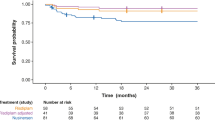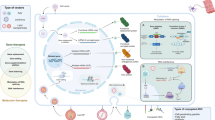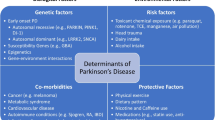Summary
Mitochondrial disorders are a heterogeneous group of diseases affecting different organs (brain, muscle, liver, and heart), and the severity of the disease is highly variable. The chronicity and heterogeneity, both clinically and genetically, means that many patients require surveillance follow-up over their lifetime, often involving multiple disciplines. Although our understanding of the genetic defects and their pathological impact underlying mitochondrial diseases has increased over the past decade, this has not been paralleled with regards to treatment. Currently, no definitive pharmacological treatment exists for patients with mitochondrial dysfunction, except for patients with primary deficiency of coenzyme Q10. Pharmacological and nonpharmacological treatments increasingly being investigated include ketogenic diet, exercise, and gene therapy. Management is aimed primarily at minimizing disability, preventing complications, and providing prognostic information and genetic counseling based on current best practice. Here, we evaluate therapies used previously and review current and future treatment modalities for both adults and children with mitochondrial disease.
Similar content being viewed by others
References
Zeviani M, Carelli V. Mitochondrial disorders. Curr Opin Neurol 2007;20: 564–571.
DiMauro S, Schon EA. Mitochondrial respiratory-chain diseases. N Engl J Med 2003;348: 2656–2668.
Schon EA, DiMauro S. Mitochondrial mutations: genotype to phenotype. Novartis Found Symp 2007;287: 214–225.
DiMauro S, Mancuso M. Mitochondrial diseases: therapeutic approaches. Biosci Rep 2007;27: 125–137.
Chinnery P, Majamaa K, Turnbull D, Thorburn D. Treatment for mitochondrial disorders. Cochrane Database Syst Rev 2006;(1): CD004426.
Chinnery PF, Bindoff LA; European Neuromuscular Center. 116th ENMC International Workshop: the treatment of mitochondrial disorders, 14th–16th March 2003, Naarden, The Netherlands. Neuromuscul Disord 2003;13: 757–764.
Chinnery PF. New approaches to the treatment of mitochondrial disorders. Reprod Biomed Online 2004;8: 16–23.
DiMauro S, Mancuso M, Naini A. Mitochondrial encephalomyopathies: therapeutic approach. Ann N Y Acad Sci 2004;1011: 232–245.
DiMauro S, Hirano M, Schon EA. Approaches to the treatment of mitochondrial diseases. Muscle Nerve 2006;34: 265–283.
Scharfer AM, McFarland R, Blakely EL, et al. Prevalence of mitochondrial DNA disease in adults. Ann Neurol 2008;63: 35–39.
Clark KM, Bindoff LA, Lightowlers RN, et al. Reversal of a mitochondrial DNA defect in human skeletal muscle. Nat Genet 1997;16: 222–224.
Chen RS, Huang CC, Chu NS. Coenzyme Q10 treatment in mitochondrial encephalomyopathies: short-term double-blind, crossover study. Eur Neurol 1997;37: 212–218.
Muller W, Reimers CD, Beminger T, Boergen K-P, Frey A, Zrenner E, et al. Coenzyme Q10 in ophthalmoplegia plus: a double blind cross over therapeutic trial. J Neurol Sci 1990;98 Suppl:442 (abstract).
Tarnopolsky MA, Roy BD, MacDonald JR. A randomized, controlled trial of creatine monohydrate in patients with mitochondrial cytopathies. Muscle Nerve 1997;20: 1502–1509.
Klopstock T, Querner V, Schmidt F, et al. A placebo-controlled crossover trial of creatine in mitochondrial diseases. Neurology 2000;55: 1748–1751.
De Stefano N, Matthews PM, Ford B, Genge A, Karpati G, Arnold DL. Short-term dichloroacetate treatment improves indices of cerebral metabolism in patients with mitochondrial disorders. Neurology 1995;45: 1193–1198.
Liet JM, Pelletier V, Robinson BH, et al. The effect of short-term dimethylglycine treatment on oxygen consumption in cytochrome oxidase deficiency: a double-blind randomized crossover clinical trial. J Pediatr 2003;142: 62–66.
Kaufmann P, Engelstad K, Wei Y, et al. Dichloroacetate causes toxic neuropathy in MELAS: a randomized, controlled clinical trial. Neurology 2006;66: 324–330.
Tein I, DiMauro S, Xie ZW, De Vivo DC. Valproic acid impairs carnitine uptake in cultured human skin fibroblasts: an in vitro model for the pathogenesis of valproic acid-associated carnitine deficiency. Pediatr Res 1993;34: 281–287.
Krähenbühl S, Brandner S, Kleinle S, Liechti S, Straumann D. Mitochondrial disease represents a risk factor for valproate induced fulminant liver failure. Liver 2000;20: 346–349.
Kollberg G, Moslemi AR, Darin N, et al. POLG1 mutations associated with progressive encephalopathy in childhood. J Neuropathol Exp Neurol 2006;65: 758–768.
Tzoulis C, Engelsen BA, Telstad W, et al. The spectrum of clinical disease caused by the A467T and W748S POLG mutations: a study of 26 cases. Brain 2006;129: 1685–1692.
Gibbs JE, Walker MC, Cock HR. Levetiracetam: antiepileptic properties and protective effects on mitochondrial dysfunction in experimental status epilepticus. Epilepsia 2006;47: 469–478.
Kang HC, Lee YM, Kim HD, Lee JS, Slama A. Safe and effective use of the ketogenic diet in children with epilepsy and mitochondrial respiratory chain complex defects. Epilepsia 2007;48: 82–88.
Luoma P, Melberg A, Rinne JO, et al. Parkinsonism, premature menopause, and mitochondrial DNA polymerase γ mutations: clinical and molecular genetic study. Lancet 2004;364: 875–882.
Horvath R, Kley RA, Lochmüller H, Vorgerd M. Parkinson syndrome, neuropathy, and myopathy caused by the mutation A8344G (MERRF) in tRNALys. Neurology 2007;68: 56–58.
Sinnathuray AR, Raut V, Awa A, Magee A, Toner JG. A review of cochlear implantation in mitochondrial sensorineural hearing loss. Otol Neurotol 2003;24: 418–426.
Sue CM, Lipsett LJ, Crimmins DS, et al. Cochlear origin of hearing loss in MELAS syndrome. Ann Neurol 1998;43: 350–359.
Yu Wai Man CY, Chinnery PF, Griffiths PG. Extraocular muscles have fundamentally distinct properties that make them selectively vulnerable to certain disorders. Neuromuscul Disord 2005;15: 17–23.
Yu Wai Man CY, Smith T, Chinnery PF, Turnbull DM, Griffiths PG. Assessment of visual function in chronic progressive external ophthalmoplegia. Eye 2006;20: 564–568.
Wong VA, Beckingsale PS, Oley CA, Sullivan TJ. Management of myogenic ptosis. Ophthalmology 2002;109: 1023–1031.
Hutnik CM, Nichols BD. Cataracts in systemic diseases and syndromes. Curr Opin Ophthalmol 1999;10: 22–28.
Horn XB, Lavine JE. Gastrointestinal complications of mitochondrial disease. Mitochondrion 2004;4: 601–607.
Guillausseau PJ, Dubois-Laforgue D, Massin P, et al; Mitochondrial Diabetes French Study Group. Heterogeneity of diabetes phenotype in patients with 3243 bp mutation of mitochondrial DNA (maternally inherited diabetes and deafness or MIDD). Diabetes Metab 2004;30: 181–186.
Holmgren D, Wåhlander H, Eriksson BO, Oldfors A, Holme E, Tulinius M. Cardiomyopathy in children with mitochondrial disease: clinical course and cardiological findings. Eur Heart J 2003;24: 280–288.
Bindoff L. Mitochondria and the heart. Eur Heart J 2003;24: 221–224.
Bonnet D, Rustin P, Rötig A, et al. Heart transplantation in children with mitochondrial cardiomyopathy. Heart 2001;86: 570–573.
Bhati RS, Sheridan BC, Mill MR, Selzman CH. Heart transplantation for progressive cardiomyopathy as a manifestation of MELAS syndrome. J Heart Lung Transplant 2005;24: 2286–2289.
Mangat J, Lunnon-Wood T, Rees P, Elliott M, Burch M. Successful cardiac transplantation in Barth syndrome: single-centre experience of four patients. Pediatr Transplant 2007;11: 327–331.
Santorelli FM, Gagliardi MG, Dionisi-Vici C, et al. Hypertrophic cardiomyopathy and mtDNA depletion: successful treatment with heart transplantation. Neuromuscul Disord 2002;12: 56–59.
Copeland WC. Inherited mitochondrial diseases of DNA replication. Annu Rev Med 2008;59: 131–146.
Dimmock DP, Dunn JK, Feigenbaum A, et al. Neurological phenotype is an important predictor of long term outcome in mitochondrial DNA depletion resulting from deoxyguanosine kinase deficiency. Liver Transpl 2008 (in press).
Horvath R, Hudson G, Ferrari G, et al. Phenotypic spectrum associated with mutations of the mitochondrial polymerase γ gene. Brain 2006;129: 1674–1684.
De Vivo DC, DiMauro S. Mitochondrial diseases. In: Swaiman KF, Ashwal S, editors. Pediatric neurology: principles & practice, 3rd ed. St Louis: Mosby; 1999: 494–509.
Nishino I, Spinazzola A, Hirano M. Thymidine phosphorylase gene mutations in MNGIE, a human mitochondrial disorder. Science 1999;283: 689–692.
Yavuz H, Ozel A, Christensen M, et al. Treatment of mitochondrial neurogastrointestinal encephalomyopathy with dialysis. Arch Neurol 2007;64: 435–438.
Hirano M, Martí R, Casali C, et al. Allogeneic stem cell transplantation corrects biochemical derangements in MNGIE. Neurology 2006;67: 1458–1460.
DiMauro S, Quinzii CM, Hirano M. Mutations in coenzyme Q10 biosynthetic genes. J Clin Invest 2007;117: 587–589.
Haas RH. The evidence basis for coenzyme Q therapy in oxidative phosphorylation disease. Mitochondrion 2007;7 Suppl:S136–S145.
Shults CW, Haas R. Clinical trials of coenzyme Q10 in neurological disorders. Biofactors 2005;25: 117–126.
Cochemé HM, Kelso GF, James AM, et al. Mitochondrial targeting of quinones: therapeutic implications. Mitochondrion 2007;7 Suppl:S94–S102.
Yamada Y, Akita H, Kogure K, Kamiya H, Harashima H. Mitochondrial drug delivery and mitochondrial disease therapy: an approach to liposome-based delivery targeted to mitochondria. Mitochondrion 2007;7: 63–71.
Rötig A, Appelkvist EL, Geromel V, et al. Quinone-responsive multiple respiratory-chain dysfunction due to widespread coenzyme Q10 deficiency. Lancet 2000;356: 391–395.
Van Maldergem L, Trijbels F, DiMauro S, et al. Coenzyme Unresponsive Leigh’s encephalopathy in two sisters. Ann Neurol 2002;52: 750–754.
Di Giovanni S, Mirabella M, Spinazzola A, et al. Coenzyme Q10 reverses pathological phenotype and reduces apoptosis in familial CoQ10 deficiency. Neurology 2001;57: 515–518.
Quinzii C, Naini A, Salviati L, et al. A mutation in para-hydroxy-benzoate-polyprenyl transferase (COQ2) causes primary coenzyme Q10 deficiency. Am J Hum Genet 2006;78: 345–349.
López LC, Schuelke M, Quinzii CM, et al. Leigh syndrome with nephropathy and CoQ10 deficiency due to decaprenyl diphosphate synthase subunit 2 (PDSS2) mutations. Am J Hum Genet 2006;79: 1125–1130.
Mollet J, Giurgea I, Schlemmer D, et al. Prenyldiphosphate synthase, subunit 1 (PDSS1) and OH-benzoate polyprenyltransferase (COQ2) mutations in ubiquinone deficiency and oxidative phosphorylation disorders. J Clin Invest 2007;117: 765–772.
Quinzii CM, López LC, Von-Moltke J, et al. Respiratory chain dysfunction and oxidative stress correlate with severity of primary CoQ10 deficiency. FASEB J 2008;22: 1874–1885.
Ferrante KL, Shefner J, Zhang H, et al. Tolerance of high-dose (3,000 mg/day) coenzyme Q10 in ALS. Neurology 2005;65: 1834–1836.
Quinzii CM, Kattah AG, Naini A, et al. Coenzyme Q deficiency and cerebellar ataxia associated with an aprataxin mutation. Neurology 2005;64: 539–541.
Lagier-Tourenne C, Tazir M, López LC, et al. ADCK3, an ancestral kinase, is mutated in a form of recessive ataxia associated with coenzyme Q10 deficiency. Am J Hum Genet 2008;82: 661–672.
Lamperti C, Naini A, Hirano M, et al. Cerebellar ataxia and coenzyme Q10 deficiency. Neurology 2003;60: 1206–1208.
Horvath R, Schneiderat P, Schoser BGH, et al. Coenzyme Q10 deficiency may cause isolated myopathy. Neurology 2006;66: 253–255.
Gempel K, Topaloglu H, Talim B, et al. The myopathic form of coenzyme Q10 deficiency is caused by mutations in the electron-transferring-flavoprotein dehydrogenase (ETFDH) gene. Brain 2007;130: 2037–2044.
Olsen RK, Olpin SE, Andresen BS, et al. ETFDH mutations as a major cause of riboflavin-responsive multiple acyl-CoA dehydrogenation deficiency. Brain 2007;130: 2045–2054.
Di Prospero NA, Baker A, Jeffries N, Fischbeck KH. Neurological effects of high-dose idebenone in patients with Friedreich’s ataxia: a randomized, placebo-controlled trial. Lancet Neurol 2007;6: 878–886.
Argov Z, Bank WJ, Maris J, et al. Treatment of mitochondrial myopathy due to complex III deficiency with vitamins K3 and C: A 31P-NMR follow-up study. Ann Neurol 1986;19: 598–602.
Keightley JA, Anitori R, Burton MD, Quan F, Buist NR, Kennaway NG. Mitochondrial encephalomyopathy and complex III deficiency associated with a stop-codon mutation in the cytochrome b gene. Am J Hum Genet 2000;67: 1400–1410.
Freisinger P, Horvath R, Macmillan C, Peters J, Jaksch M. Reversion of hypertrophic cardiomyopathy in a patient with deficiency of the mitochondrial copper binding protein Sco2: is there a potential effect of copper? J Inherit Metab Dis 2004;27: 67–79.
Taanman JW, Muddle JR, Muntau AC. Mitochondrial DNA depletion can be prevented by dGMP and dAMP supplementation in a resting culture of deoxyguanosine kinase-deficient fibroblasts. Hum Mol Genet 2003;12: 1839–1845.
Beal MF. Mitochondria take center stage in aging and neurodegeneration. Ann Neurol 2005;58: 495–505.
Mancuso C, Scapagini G, Currò D, et al. Mitochondrial dysfunction, free radical generation and cellular stress response in neurodegenerative disorders. Front Biosci 2007;12: 1107–1123.
Rodriguez MC, MacDonald JR, Mahoney DJ, Parise G, Beal MF, Tarnopolsky MA. Beneficial effects of creatine, CoQ10, and lipoic acid in mitochondrial disorders. Muscle Nerve 2007;35: 235–242.
Taylor RW, Chinnery PF, Turnbull DM, Lightowlers RN. Selective inhibition of mutant human mitochondrial DNA replication in vitro by peptide nucleic acids. Nat Genet 1997;15: 212–215.
Chinnery PF, Taylor RW, Diekert K, Lill R, Turnbull DM, Lightowlers RN. Peptide nucleic acid delivery to human mitochondria [Erratum in: Gene Ther 2000;7:813]. Gene Ther 1999;6: 1919–1928.
Kolesnikova OA, Entelis NS, Jacquin-Becker C, et al. Nuclear DNA-encoded tRNAs targeted into mitochondria can rescue a mitochondrial DNA mutation associated with the MERRF syndrome in cultured human cells. Hum Mol Genet 2004;13: 2519–2534.
Manfredi G, Gupta N, Vazquez-Memije ME, et al. Oligomycin induces a decrease in the cellular content of a pathogenic mutation in the human mitochondrial ATPase 6 gene. J Biol Chem 1999;274: 9386–9391.
Santra S, Gilkerson RW, Davidson M, Schon EA. Ketogenic treatment reduces deleted mitochondrial DNAs in cultured human cells. Ann Neurol 2004;56: 662–669.
Maalouf M, Sullivan PG, Davis L, Kim DY, Rho JM. Ketones inhibit mitochondrial production of reactive oxygen species production following glutamate excitotoxicity by increasing NADH oxidation. Neuroscience 2007;145: 256–264.
Taivassalo T, Fu K, Johns T, Arnold D, Karpati G, Shoubridge EA. Gene shifting: a novel therapy for mitochondrial myopathy. Hum Mol Genet 1999;8: 1047–1052.
Andrews RM, Griffiths PG, Chinnery PF, Turnbull DM. Evaluation of bupivacaine-induced muscle regeneration in the treatment of ptosis in patients with chronic progressive external ophthalmoplegia and Kearns-Sayre syndrome. Eye 1999;13: 769–772.
Karadimas CL, Greenstein P, Sue CM, et al. Recurrent myoglobinuria due to a nonsense mutation in the COX I gene of mitochondrial DNA. Neurology 2000;55: 644–649.
Gardner JL, Craven L, Turnbull DM, Taylor RW. Experimental strategies towards treating mitochondrial DNA disorders. Biosci Rep 2007;27: 139–150.
Jeppesen TD, Schwartz M, Olsen DB, et al. Aerobic training is safe and improves exercise capacity in patients with mitochondrial myopathy. Brain 2006;129: 3402–3412.
Taivassalo T, Gardner JL, Taylor RW, et al. Endurance training and detraining in mitochondrial myopathies due to single large-scale mtDNA deletions. Brain 2006: 129: 3391–3401.
Brown DT, Herbert M, Lamb VK, et al. Transmission of mitochondrial DNA disorders: possibilities for the future. Lancet 2006;368: 87–89.
Gardner DK, Sheehan CB, Rienzi L, Katz-Jaffe M, Larman MG. Analysis of oocyte physiology to improve cryopreservation procedures. Theriogenology 2007;67: 64–72.
Steffann J, Feyereisen E, Kerbrat V, Romana S, Frydman N. Prenatal and preimplantation genetic diagnosis: decision tree, new practices? [In French]. Med Sci (Paris) 2005;21: 987–992.
Cohen J, Scott R, Schimmel T, Levron J, Willadsen S. Birth of infant after transfer of anucleate donor oocyte cytoplasm into recipient eggs. Lancet 1997;350: 186–187.
Roberts RM. Prevention of human mitochondrial (mtDNA) disease by nucleus transplantation into an enucleated donor oocyte. Am J Med Genet 1999;87: 265–266.
McGrath J, Solter D. Nuclear transplantation in the mouse embryo by microsurgery and cell fusion. Science 1983;220: 1300–1302.
Schaefer AM, Phoenix C, Elson JL, McFarland R, Chinnery PF, Tumbull DM. Mitochondrial disease in adults: a scale to monitor progression and treatment. Neurology 2006;66: 1932–1934.
Phoenix C, Schaefer AM, Elson JL, et al. A scale to monitor progression and treatment of mitochondrial disease in children. Neuromuscul Disord 2006;16: 814–820.
Author information
Authors and Affiliations
Corresponding author
Rights and permissions
About this article
Cite this article
Horvath, R., Gorman, G. & Chinnery, P.F. How can we treat mitochondrial encephalomyopathies? approaches to therapy. Neurotherapeutics 5, 558–568 (2008). https://doi.org/10.1016/j.nurt.2008.07.002
Published:
Issue Date:
DOI: https://doi.org/10.1016/j.nurt.2008.07.002




